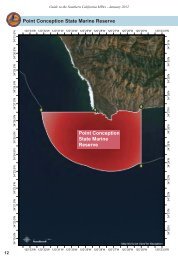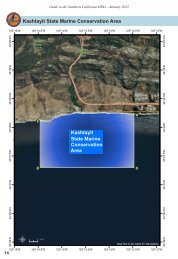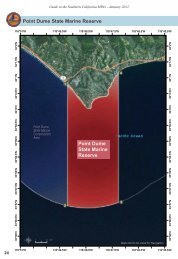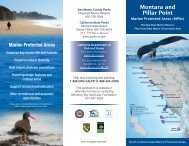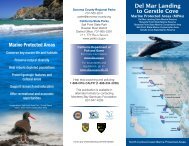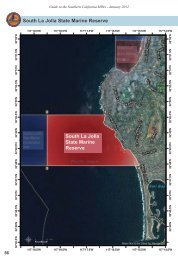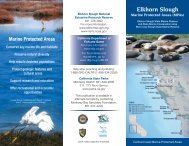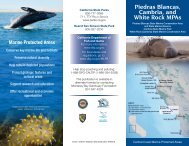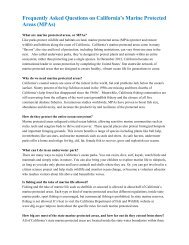Point Lobos
Point Lobos Brochure - California MPA Educational Resources
Point Lobos Brochure - California MPA Educational Resources
- No tags were found...
You also want an ePaper? Increase the reach of your titles
YUMPU automatically turns print PDFs into web optimized ePapers that Google loves.
om rocky shores to the depths of Monterey Canyon<br />
California Is Making a Difference<br />
by creating a statewide network of marine<br />
protected areas (MPAs). Marine protected<br />
areas are underwater places designed<br />
to protect key habitats and species by<br />
prohibiting or restricting the take of marine<br />
life. Just as the nation’s parks, forests and<br />
wilderness areas protect special places<br />
on land, California’s MPAs protect unique<br />
areas in the ocean. The California MPA<br />
network includes the many different types<br />
of habitats found along our coast, from<br />
sheltered estuaries and lush kelp forests to<br />
steep underwater canyons.<br />
Image above left: giant green anemone (Jerry Kirkhart)<br />
above right: diver silhouette (Jerry Loomis)<br />
<strong>Point</strong> <strong>Lobos</strong>: The Greatest Meeting<br />
of Land and Water<br />
<strong>Point</strong> <strong>Lobos</strong>, a crown jewel for California,<br />
teems with life. Its hiking trails offer vistas<br />
of sea-splashed cliffs, windswept Monterey<br />
cypress trees, and lush kelp beds where<br />
endangered sea otters frolic. Sleek harbor<br />
seals rest and give birth on the cove’s small<br />
beach. Sea lions congregate on rocks<br />
offshore. The place is so spectacular both<br />
above and below the water line that the<br />
state of California prohibits removal of any<br />
natural resources on land or in the water.<br />
Amazing Diversity of Life<br />
• Many species of fish live in the rocky<br />
tidepools, kelp forests, sandy bottoms<br />
and deep canyons off <strong>Point</strong> <strong>Lobos</strong>.<br />
Cabezon, vermillion rockfish and blue<br />
rockfish hide among the kelp, while<br />
mola mola may be found basking on the<br />
surface offshore. Goby and sculpin can<br />
be found darting amongst the tidepools.<br />
• Marine mammals such as sea otters, sea<br />
lions and harbor seals find shelter along<br />
the shore.<br />
• Invertebrates such as abalone are slowly<br />
rebounding with protection.<br />
• Over 300 species of birds can be found<br />
benefiting from the abundance of food<br />
and habitat afforded by protected land<br />
and seas.<br />
Recognized Throughout History<br />
<strong>Point</strong> <strong>Lobos</strong> has long been cherished.<br />
Native Rumsien harvested fish and<br />
shellfish long before European explorers<br />
arrived. From the 1850s to the 1930s,<br />
<strong>Point</strong> <strong>Lobos</strong> played host to a number<br />
of industries: fishing, whaling, a granite<br />
quarry, a coal port and a large abalone<br />
fishing operation. Today the area is<br />
recognized by nature enthusiasts who<br />
hike, photograph, kayak, SCUBA dive,<br />
snorkel and enjoy a “look but do NOT<br />
disturb” approach to wildlife.<br />
Hopkins’ rose nudibranch<br />
(Jerry Loomis)<br />
harbor seal (Steve Lonhart)<br />
strawberry anemone (Jerry Loomis)<br />
giant kelp (Jerry Loomis)<br />
copper rockfish (Chad King)<br />
brown pelican (Jerry Kirkhart)




